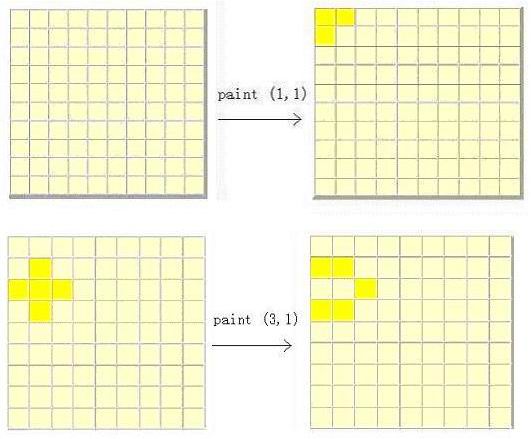poj 1681 Painter's Problem (高斯消元)
来源:互联网 发布:javascript和php哪个好 编辑:程序博客网 时间:2024/04/23 16:16
Painter's Problem
Time Limit: 1000MS Memory Limit: 10000KTotal Submissions: 5079 Accepted: 2460
Description
There is a square wall which is made of n*n small square bricks. Some bricks are white while some bricks are yellow. Bob is a painter and he wants to paint all the bricks yellow. But there is something wrong with Bob's brush. Once he uses this brush to paint brick (i, j), the bricks at (i, j), (i-1, j), (i+1, j), (i, j-1) and (i, j+1) all change their color. Your task is to find the minimum number of bricks Bob should paint in order to make all the bricks yellow.


Input
The first line contains a single integer t (1 <= t <= 20) that indicates the number of test cases. Then follow the t cases. Each test case begins with a line contains an integer n (1 <= n <= 15), representing the size of wall. The next n lines represent the original wall. Each line contains n characters. The j-th character of the i-th line figures out the color of brick at position (i, j). We use a 'w' to express a white brick while a 'y' to express a yellow brick.
Output
For each case, output a line contains the minimum number of bricks Bob should paint. If Bob can't paint all the bricks yellow, print 'inf'.
Sample Input
23yyyyyyyyy5wwwwwwwwwwwwwwwwwwwwwwwww
Sample Output
015
高斯消元,枚举自由变元
/*======================================================# Author: whai# Last modified: 2015-10-07 16:10# Filename: poj1681.cpp======================================================*/#include <iostream>#include <cstdio>#include <vector>#include <algorithm>#include <cstring>#include <string>#include <cmath>#include <set>#include <map>using namespace std;#define LL __int64#define PB push_back#define P pair<int, int>#define X first#define Y secondconst int N = 20 * 20;char str[N][N];LL inv(LL a, LL m) {LL p = 1, q = 0, b = m, c, d;while (b > 0) {c = a / b;d = a; a = b; b = d % b;d = p; p = q; q = d - c * q;}return p < 0 ? p + m : p;}const int G_MOD = 2;struct Gauss {int f[N][N]; //第一维为等式0~n-1, 第二维为变元0~m-1, m是解int x[N]; //解int f_x[N], f_tot; //自由变元的列号//n表示等式个数,m表示变元个数int gauss(int n, int m) {int i, c;for(i = 0, c = 0; i < n && c < m; ++c) {int k = i;while(k < n && !f[k][c]) ++k;if(f[k][c] == 0) {f_x[f_tot++] = c;continue;}for(int j = c; j <= m; ++j)swap(f[i][j], f[k][j]);for(int j = 0; j < n; ++j)if(i != j && f[j][c]) {int tmp = f[j][c] * inv(f[i][c], G_MOD) % G_MOD;for(int k = 0; k <= m; ++k) {f[j][k] = ((f[j][k] - f[i][k] * tmp) % G_MOD + G_MOD) % G_MOD;}}++i;}for(int j = i; j < n; ++j) if(f[j][m]) return -1;if(i < m) return m - i;for(int j = m - 1; j >= 0; --j) {x[j] = f[j][m] * inv(f[j][j], G_MOD) % G_MOD;}return 0;}void init() {f_tot = 0;memset(f, 0, sizeof(f));}}g;bool ok(int x, int y, int n) {if(x >= 0 && x < n && y >= 0 && y < n) return true;return false;}int dx[] = {-1, 1, 0, 0};int dy[] = {0, 0, -1, 1};void deal(int x, int y, int n) {int u = x * n + y;g.f[u][u] = 1;int st = 0;if(str[x][y] == 'w') st = 1;g.f[u][n * n] = st ^ 0;for(int i = 0; i < 4; ++i) {int tmpx = x + dx[i];int tmpy = y + dy[i];if(ok(tmpx, tmpy, n)) {int v = tmpx * n + tmpy;g.f[v][u] = 1;}}}void gao(int n) {g.init();for(int i = 0; i < n; ++i) {for(int j = 0; j < n; ++j) {deal(i, j, n);}}int flag = g.gauss(n * n, n * n);if(flag == -1) puts("inf");else if(flag == 0){int ans = 0;for(int i = 0; i < n * n; ++i) {ans += g.f[i][n * n];}cout<<ans<<endl;} else {int maxx = (1<<flag);int var = n * n;int ans = var;for(int x = 0; x < maxx; ++x) {int cnt = 0;for(int i = 0; i < flag; ++i) {if(x & (1 << i)) {g.x[g.f_x[i]] = 1;++cnt;} else {g.x[g.f_x[i]] = 0;}}for(int i = var - 1 - flag; i >= 0; --i) {int tmp = g.f[i][var];for(int j = i + 1; j < var; ++j) {if(g.f[i][j])tmp ^= g.x[j];}cnt += tmp;}ans = min(ans, cnt);}cout<<ans<<endl;}}int main() {int T;scanf("%d", &T);while(T--) {int n;scanf("%d", &n);for(int i = 0; i < n; ++i) {scanf("%s", str[i]);}gao(n);}return 0;} 0 0
- poj 1681 Painter's Problem 高斯消元
- poj 1681 Painter's Problem(高斯消元)
- poj 1681 Painter's Problem(高斯消元)
- poj 1681 Painter's Problem 高斯消元
- POJ 1681 Painter's Problem (高斯消元)
- poj 1681 Painter's Problem (高斯消元)
- poj 1681 Painter's Problem (高斯消元)
- 【高斯消元】poj 1681 Painter's Problem
- 【POJ 1681】 Painter's Problem (高斯消元)
- POJ 1681 Painter's Problem (高斯消元)
- POJ 1681 Painter's Problem(高斯消元)
- POJ 1681 Painter's Problem(高斯消元)
- poj 1681 Painter's Problem (高斯消元)
- POJ 1681 Painter's Problem(高斯消元)
- POJ 1681 Painter's Problem (高斯消元)
- poj 1681 Painter's Problem(高斯消元)
- POJ 1681 Painter's Problem
- poj 1681 Painter's Problem
- acmPOJ--1847
- 软件工程第二章作业
- 虚函数
- 使用 adb 命令给TCL智能电视安装新软件
- MySQL之SQL分析三部曲实际案例
- poj 1681 Painter's Problem (高斯消元)
- vim配置及插件安装管理(超级详细)
- 过度
- 保护你的redis,给你的redis加“锁”
- java.lang.RuntimeException: Unable to start activity ComponentInfo{包名/类名}
- html基础加强
- /*自守数 如果某个数的平方的末尾几位数等于这个数,那么就称这个数为自守数。*/
- 第六周--项目三--括号的匹配
- android wifi连接与断开


